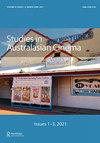Carnivalesque subversion and the narrative gaze of children: Taika Waititi’s Boy (2010), Hunt for the Wilderpeople (2016), and Jojo Rabbit (2019)
IF 0.7
0 FILM, RADIO, TELEVISION
引用次数: 0
Abstract
ABSTRACT This article studies the carnivalesque subversion of oppressive systems using the narrative gaze of children in Taika Waititi’s three films, Boy (2010), Hunt for the Wilderpeople (2016), and Jojo Rabbit (2019). Waititi has a wide range of filmography to his assets and his films, while comically articulating his politics, incorporate new vocabularies to tackle various forms of oppression. The selected films are of both local and international nature, and they voice their politics through the varying presence of carnivalesque motifs of subversion. The current paper attempts to investigate them using Bakhtin’s theory of the carnivalesque. By arguing that these films are a vehicle of his personal and political credence, this paper attempts to bridge the gap in theorizing Waititi’s filmography despite being critically acclaimed.狂欢节式的颠覆与儿童的叙事凝视:Taika Waititi的《男孩》(2010)、《荒野猎人》(2016)和《Jojo Rabbit》(2019)
摘要本文以塔伊卡·怀蒂蒂的三部电影《男孩》(2010)、《猎野人》(2016)和《乔乔兔》(2019)中儿童的叙事视角,研究了对压迫制度的狂欢式颠覆。怀蒂蒂拥有广泛的电影作品,他的电影在滑稽地表达他的政治观点的同时,融入了新的词汇来解决各种形式的压迫。入选的电影既有本地的,也有国际的,它们通过各种形式的狂欢式的颠覆主题来表达自己的政治观点。本文试图运用巴赫金的狂欢主义理论对其进行考察。通过论证这些电影是他个人和政治信仰的载体,本文试图弥合理论上的差距,尽管怀蒂蒂的电影作品受到好评。
本文章由计算机程序翻译,如有差异,请以英文原文为准。
求助全文
约1分钟内获得全文
求助全文

 求助内容:
求助内容: 应助结果提醒方式:
应助结果提醒方式:


